Comprehensive Risk Management Report: Lewis Project Case Study
VerifiedAdded on 2022/09/14
|8
|1331
|12
Report
AI Summary
This report focuses on risk management strategies for the Lewis project, undertaken by Robert Frank Company in collaboration with Lewis Company. It begins with an introduction to risk management and its importance in identifying, assessing, and controlling risks. The report delves into risk identification, including budget, resource, scope, schedule, technology, stakeholder, and quality risks. Each risk is analyzed with its likelihood, impact, and severity, along with proposed mitigation actions. A risk register and probability-impact matrix are presented to prioritize risks. The report then discusses risk management strategies, including avoidance, transfer, mitigation, and acceptance, and assigns appropriate response strategies to each identified risk. Finally, it outlines the roles of stakeholders in risk management activities, concluding that effective risk management is crucial for the project's success and provides a detailed analysis of potential vulnerabilities.
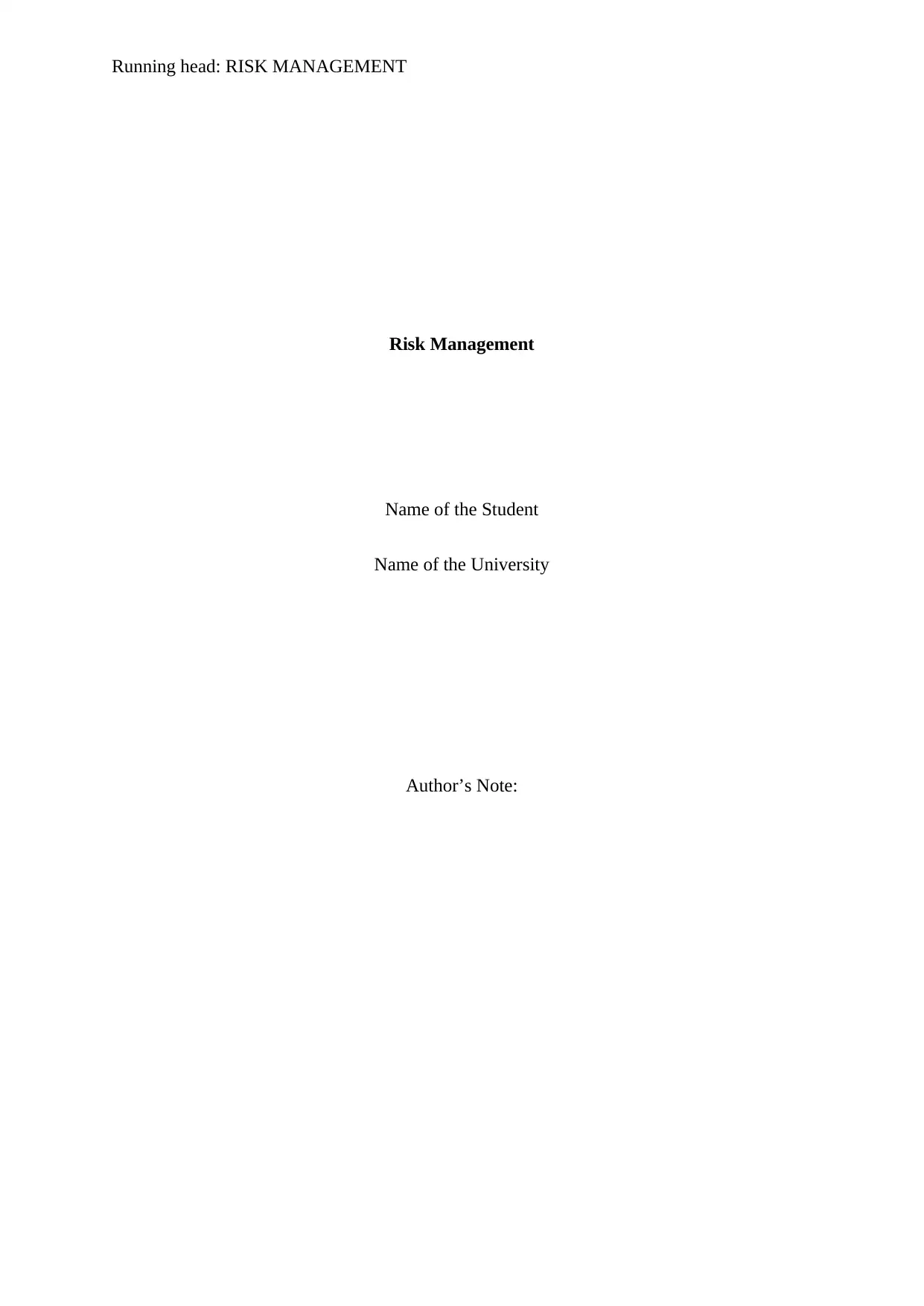
Running head: RISK MANAGEMENT
Risk Management
Name of the Student
Name of the University
Author’s Note:
Risk Management
Name of the Student
Name of the University
Author’s Note:
Paraphrase This Document
Need a fresh take? Get an instant paraphrase of this document with our AI Paraphraser
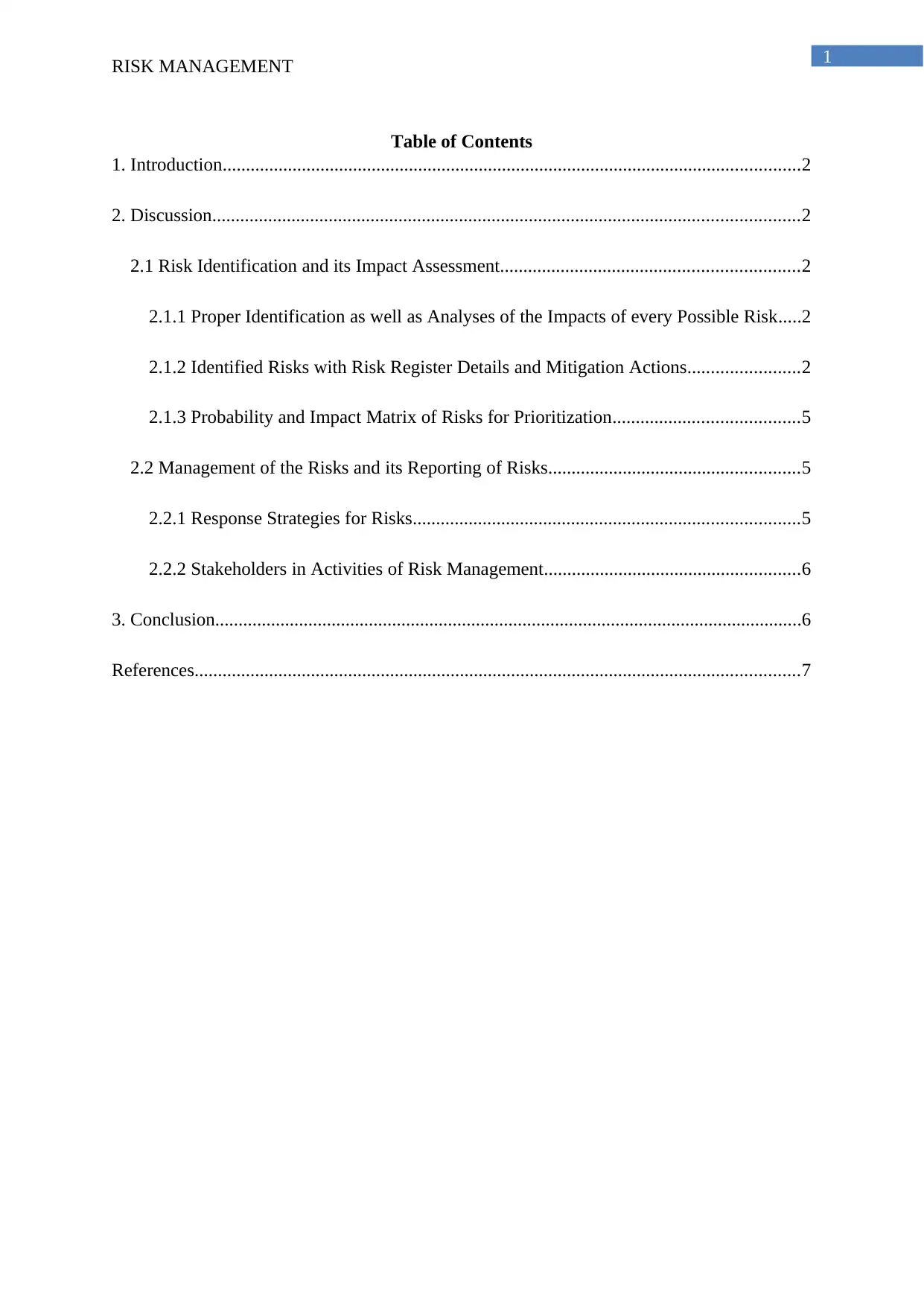
1
RISK MANAGEMENT
Table of Contents
1. Introduction............................................................................................................................2
2. Discussion..............................................................................................................................2
2.1 Risk Identification and its Impact Assessment................................................................2
2.1.1 Proper Identification as well as Analyses of the Impacts of every Possible Risk.....2
2.1.2 Identified Risks with Risk Register Details and Mitigation Actions........................2
2.1.3 Probability and Impact Matrix of Risks for Prioritization........................................5
2.2 Management of the Risks and its Reporting of Risks......................................................5
2.2.1 Response Strategies for Risks...................................................................................5
2.2.2 Stakeholders in Activities of Risk Management.......................................................6
3. Conclusion..............................................................................................................................6
References..................................................................................................................................7
RISK MANAGEMENT
Table of Contents
1. Introduction............................................................................................................................2
2. Discussion..............................................................................................................................2
2.1 Risk Identification and its Impact Assessment................................................................2
2.1.1 Proper Identification as well as Analyses of the Impacts of every Possible Risk.....2
2.1.2 Identified Risks with Risk Register Details and Mitigation Actions........................2
2.1.3 Probability and Impact Matrix of Risks for Prioritization........................................5
2.2 Management of the Risks and its Reporting of Risks......................................................5
2.2.1 Response Strategies for Risks...................................................................................5
2.2.2 Stakeholders in Activities of Risk Management.......................................................6
3. Conclusion..............................................................................................................................6
References..................................................................................................................................7
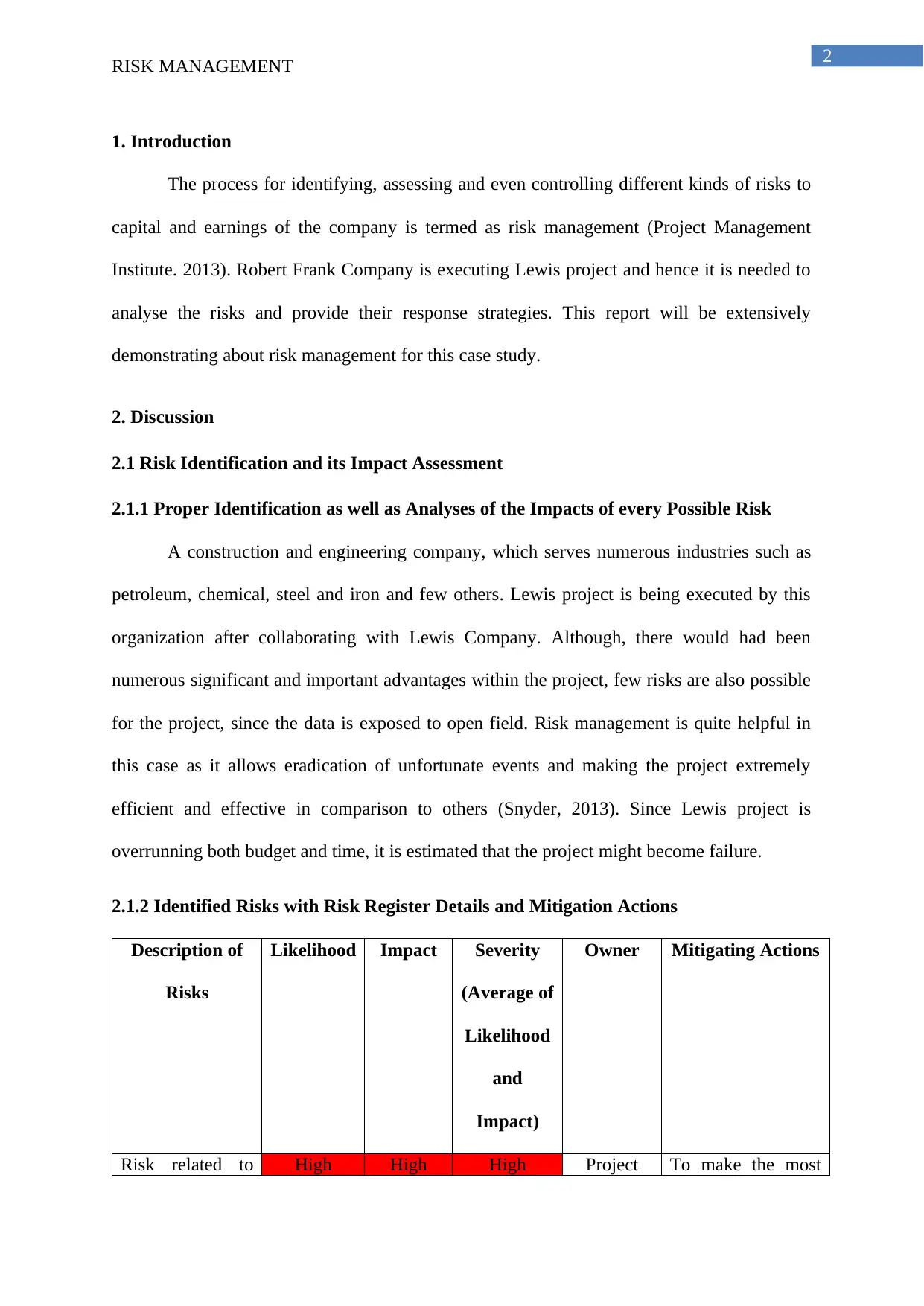
2
RISK MANAGEMENT
1. Introduction
The process for identifying, assessing and even controlling different kinds of risks to
capital and earnings of the company is termed as risk management (Project Management
Institute. 2013). Robert Frank Company is executing Lewis project and hence it is needed to
analyse the risks and provide their response strategies. This report will be extensively
demonstrating about risk management for this case study.
2. Discussion
2.1 Risk Identification and its Impact Assessment
2.1.1 Proper Identification as well as Analyses of the Impacts of every Possible Risk
A construction and engineering company, which serves numerous industries such as
petroleum, chemical, steel and iron and few others. Lewis project is being executed by this
organization after collaborating with Lewis Company. Although, there would had been
numerous significant and important advantages within the project, few risks are also possible
for the project, since the data is exposed to open field. Risk management is quite helpful in
this case as it allows eradication of unfortunate events and making the project extremely
efficient and effective in comparison to others (Snyder, 2013). Since Lewis project is
overrunning both budget and time, it is estimated that the project might become failure.
2.1.2 Identified Risks with Risk Register Details and Mitigation Actions
Description of
Risks
Likelihood Impact Severity
(Average of
Likelihood
and
Impact)
Owner Mitigating Actions
Risk related to High High High Project To make the most
RISK MANAGEMENT
1. Introduction
The process for identifying, assessing and even controlling different kinds of risks to
capital and earnings of the company is termed as risk management (Project Management
Institute. 2013). Robert Frank Company is executing Lewis project and hence it is needed to
analyse the risks and provide their response strategies. This report will be extensively
demonstrating about risk management for this case study.
2. Discussion
2.1 Risk Identification and its Impact Assessment
2.1.1 Proper Identification as well as Analyses of the Impacts of every Possible Risk
A construction and engineering company, which serves numerous industries such as
petroleum, chemical, steel and iron and few others. Lewis project is being executed by this
organization after collaborating with Lewis Company. Although, there would had been
numerous significant and important advantages within the project, few risks are also possible
for the project, since the data is exposed to open field. Risk management is quite helpful in
this case as it allows eradication of unfortunate events and making the project extremely
efficient and effective in comparison to others (Snyder, 2013). Since Lewis project is
overrunning both budget and time, it is estimated that the project might become failure.
2.1.2 Identified Risks with Risk Register Details and Mitigation Actions
Description of
Risks
Likelihood Impact Severity
(Average of
Likelihood
and
Impact)
Owner Mitigating Actions
Risk related to High High High Project To make the most
⊘ This is a preview!⊘
Do you want full access?
Subscribe today to unlock all pages.

Trusted by 1+ million students worldwide
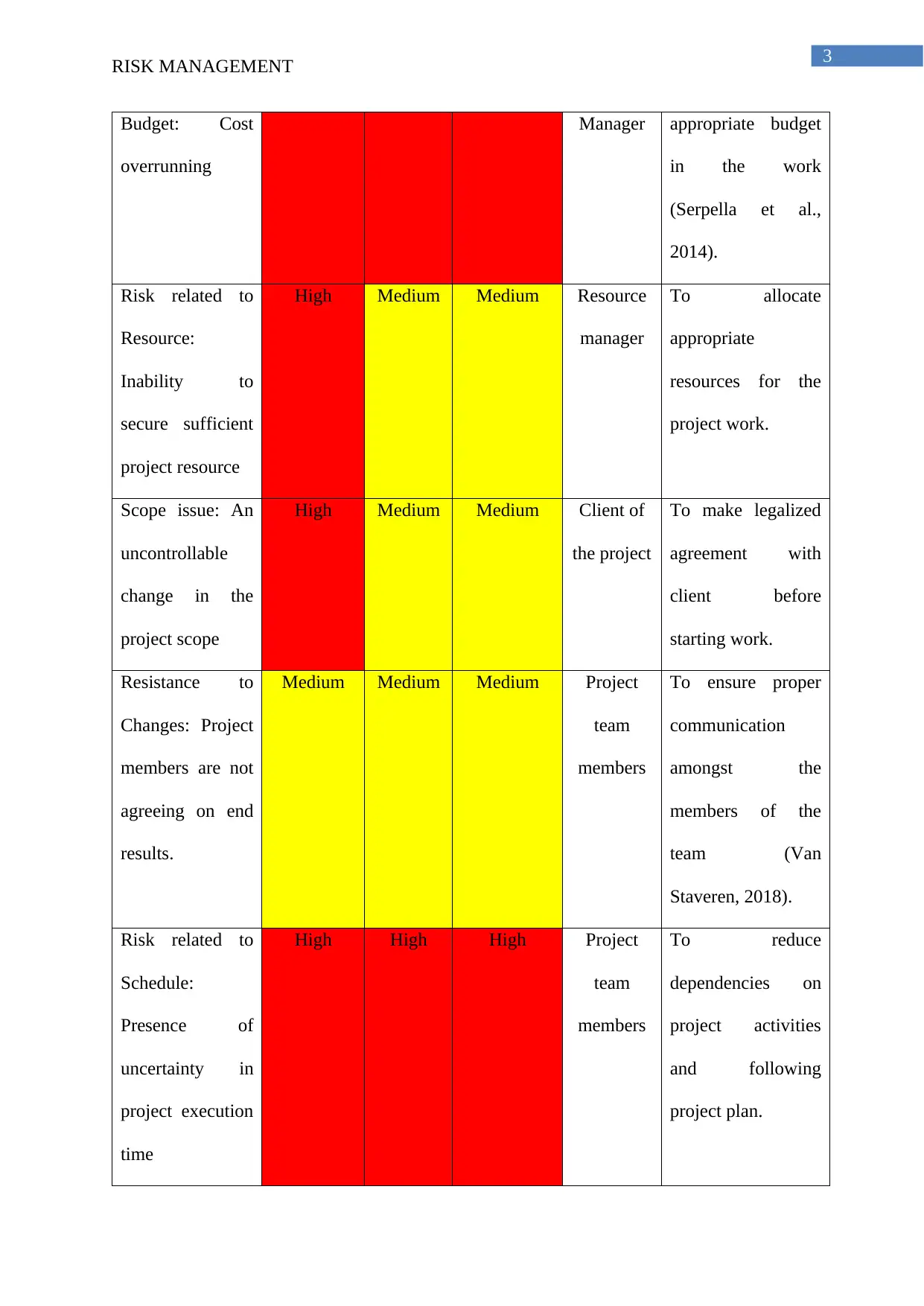
3
RISK MANAGEMENT
Budget: Cost
overrunning
Manager appropriate budget
in the work
(Serpella et al.,
2014).
Risk related to
Resource:
Inability to
secure sufficient
project resource
High Medium Medium Resource
manager
To allocate
appropriate
resources for the
project work.
Scope issue: An
uncontrollable
change in the
project scope
High Medium Medium Client of
the project
To make legalized
agreement with
client before
starting work.
Resistance to
Changes: Project
members are not
agreeing on end
results.
Medium Medium Medium Project
team
members
To ensure proper
communication
amongst the
members of the
team (Van
Staveren, 2018).
Risk related to
Schedule:
Presence of
uncertainty in
project execution
time
High High High Project
team
members
To reduce
dependencies on
project activities
and following
project plan.
RISK MANAGEMENT
Budget: Cost
overrunning
Manager appropriate budget
in the work
(Serpella et al.,
2014).
Risk related to
Resource:
Inability to
secure sufficient
project resource
High Medium Medium Resource
manager
To allocate
appropriate
resources for the
project work.
Scope issue: An
uncontrollable
change in the
project scope
High Medium Medium Client of
the project
To make legalized
agreement with
client before
starting work.
Resistance to
Changes: Project
members are not
agreeing on end
results.
Medium Medium Medium Project
team
members
To ensure proper
communication
amongst the
members of the
team (Van
Staveren, 2018).
Risk related to
Schedule:
Presence of
uncertainty in
project execution
time
High High High Project
team
members
To reduce
dependencies on
project activities
and following
project plan.
Paraphrase This Document
Need a fresh take? Get an instant paraphrase of this document with our AI Paraphraser
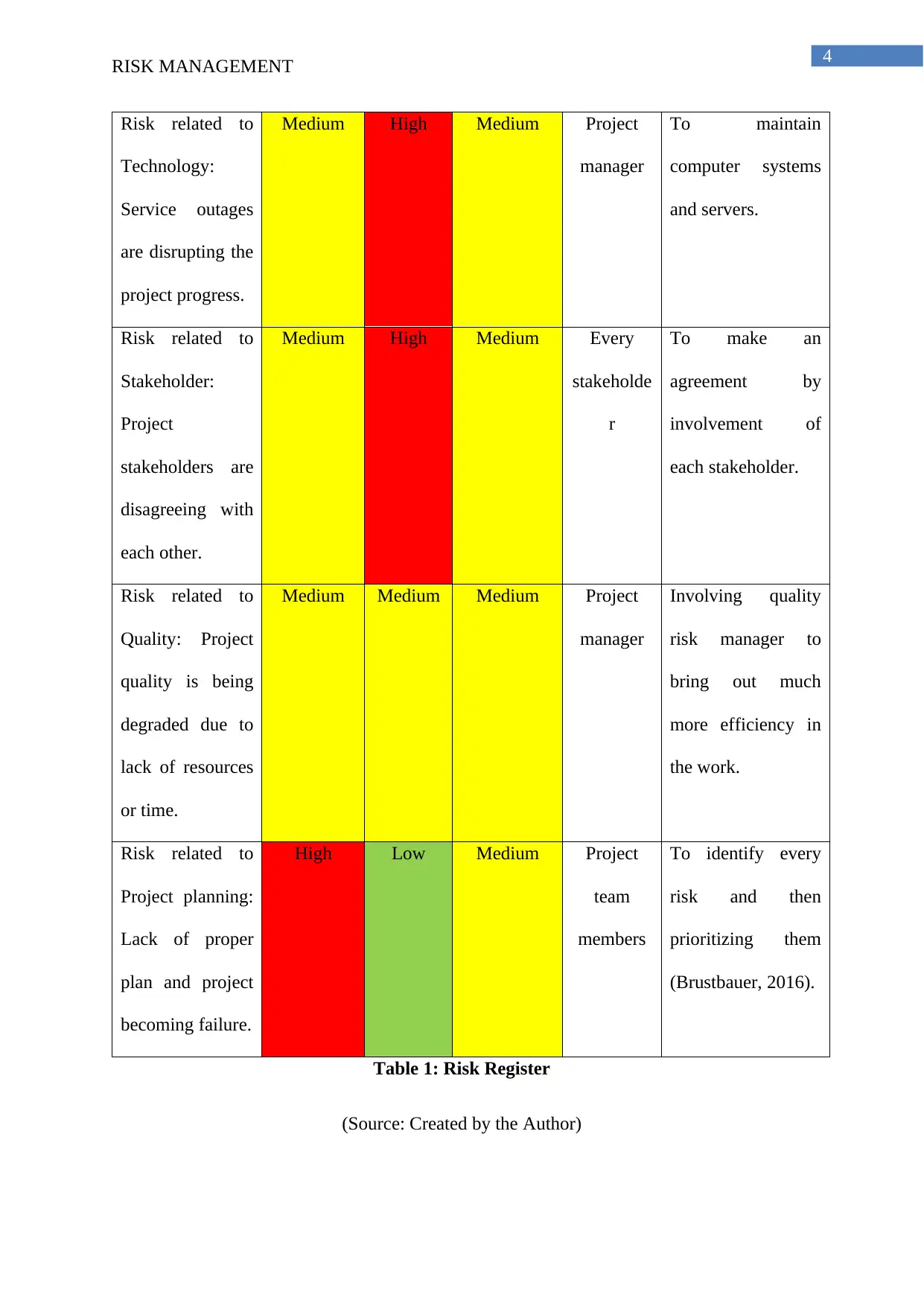
4
RISK MANAGEMENT
Risk related to
Technology:
Service outages
are disrupting the
project progress.
Medium High Medium Project
manager
To maintain
computer systems
and servers.
Risk related to
Stakeholder:
Project
stakeholders are
disagreeing with
each other.
Medium High Medium Every
stakeholde
r
To make an
agreement by
involvement of
each stakeholder.
Risk related to
Quality: Project
quality is being
degraded due to
lack of resources
or time.
Medium Medium Medium Project
manager
Involving quality
risk manager to
bring out much
more efficiency in
the work.
Risk related to
Project planning:
Lack of proper
plan and project
becoming failure.
High Low Medium Project
team
members
To identify every
risk and then
prioritizing them
(Brustbauer, 2016).
Table 1: Risk Register
(Source: Created by the Author)
RISK MANAGEMENT
Risk related to
Technology:
Service outages
are disrupting the
project progress.
Medium High Medium Project
manager
To maintain
computer systems
and servers.
Risk related to
Stakeholder:
Project
stakeholders are
disagreeing with
each other.
Medium High Medium Every
stakeholde
r
To make an
agreement by
involvement of
each stakeholder.
Risk related to
Quality: Project
quality is being
degraded due to
lack of resources
or time.
Medium Medium Medium Project
manager
Involving quality
risk manager to
bring out much
more efficiency in
the work.
Risk related to
Project planning:
Lack of proper
plan and project
becoming failure.
High Low Medium Project
team
members
To identify every
risk and then
prioritizing them
(Brustbauer, 2016).
Table 1: Risk Register
(Source: Created by the Author)
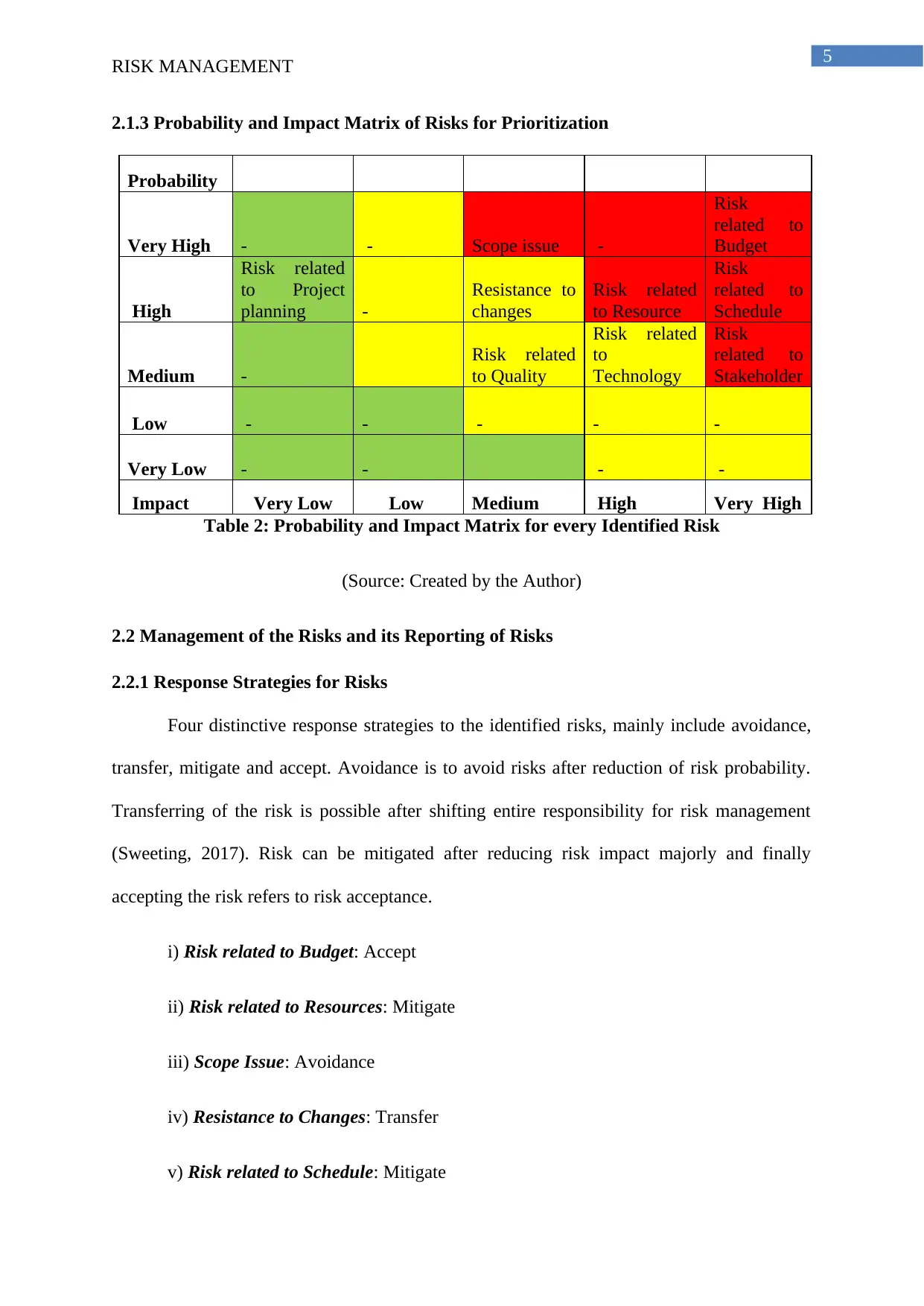
5
RISK MANAGEMENT
2.1.3 Probability and Impact Matrix of Risks for Prioritization
Probability
Very High - - Scope issue -
Risk
related to
Budget
High
Risk related
to Project
planning -
Resistance to
changes
Risk related
to Resource
Risk
related to
Schedule
Medium -
Risk related
to Quality
Risk related
to
Technology
Risk
related to
Stakeholder
Low - - - - -
Very Low - - - -
Impact Very Low Low Medium High Very High
Table 2: Probability and Impact Matrix for every Identified Risk
(Source: Created by the Author)
2.2 Management of the Risks and its Reporting of Risks
2.2.1 Response Strategies for Risks
Four distinctive response strategies to the identified risks, mainly include avoidance,
transfer, mitigate and accept. Avoidance is to avoid risks after reduction of risk probability.
Transferring of the risk is possible after shifting entire responsibility for risk management
(Sweeting, 2017). Risk can be mitigated after reducing risk impact majorly and finally
accepting the risk refers to risk acceptance.
i) Risk related to Budget: Accept
ii) Risk related to Resources: Mitigate
iii) Scope Issue: Avoidance
iv) Resistance to Changes: Transfer
v) Risk related to Schedule: Mitigate
RISK MANAGEMENT
2.1.3 Probability and Impact Matrix of Risks for Prioritization
Probability
Very High - - Scope issue -
Risk
related to
Budget
High
Risk related
to Project
planning -
Resistance to
changes
Risk related
to Resource
Risk
related to
Schedule
Medium -
Risk related
to Quality
Risk related
to
Technology
Risk
related to
Stakeholder
Low - - - - -
Very Low - - - -
Impact Very Low Low Medium High Very High
Table 2: Probability and Impact Matrix for every Identified Risk
(Source: Created by the Author)
2.2 Management of the Risks and its Reporting of Risks
2.2.1 Response Strategies for Risks
Four distinctive response strategies to the identified risks, mainly include avoidance,
transfer, mitigate and accept. Avoidance is to avoid risks after reduction of risk probability.
Transferring of the risk is possible after shifting entire responsibility for risk management
(Sweeting, 2017). Risk can be mitigated after reducing risk impact majorly and finally
accepting the risk refers to risk acceptance.
i) Risk related to Budget: Accept
ii) Risk related to Resources: Mitigate
iii) Scope Issue: Avoidance
iv) Resistance to Changes: Transfer
v) Risk related to Schedule: Mitigate
⊘ This is a preview!⊘
Do you want full access?
Subscribe today to unlock all pages.

Trusted by 1+ million students worldwide
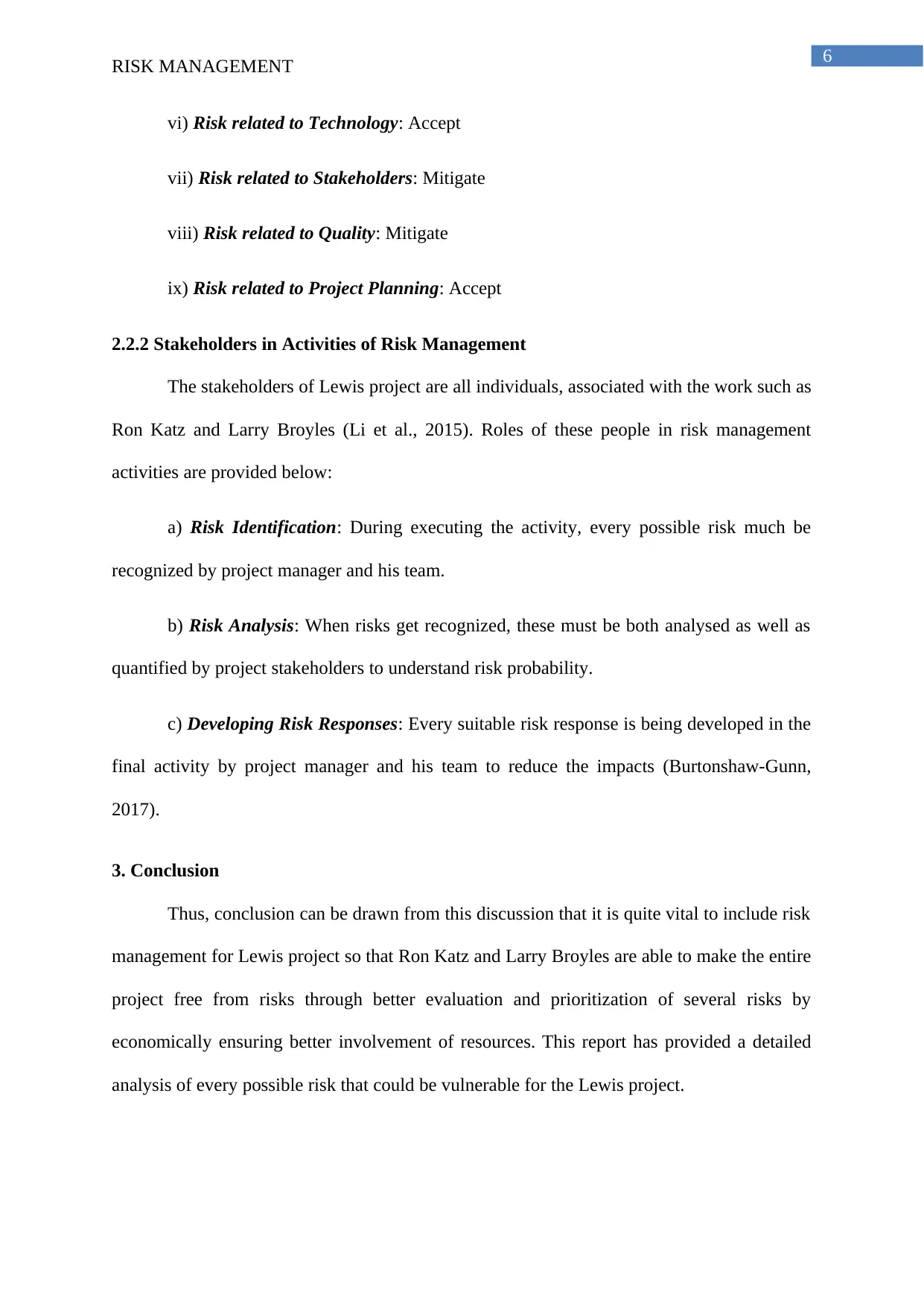
6
RISK MANAGEMENT
vi) Risk related to Technology: Accept
vii) Risk related to Stakeholders: Mitigate
viii) Risk related to Quality: Mitigate
ix) Risk related to Project Planning: Accept
2.2.2 Stakeholders in Activities of Risk Management
The stakeholders of Lewis project are all individuals, associated with the work such as
Ron Katz and Larry Broyles (Li et al., 2015). Roles of these people in risk management
activities are provided below:
a) Risk Identification: During executing the activity, every possible risk much be
recognized by project manager and his team.
b) Risk Analysis: When risks get recognized, these must be both analysed as well as
quantified by project stakeholders to understand risk probability.
c) Developing Risk Responses: Every suitable risk response is being developed in the
final activity by project manager and his team to reduce the impacts (Burtonshaw-Gunn,
2017).
3. Conclusion
Thus, conclusion can be drawn from this discussion that it is quite vital to include risk
management for Lewis project so that Ron Katz and Larry Broyles are able to make the entire
project free from risks through better evaluation and prioritization of several risks by
economically ensuring better involvement of resources. This report has provided a detailed
analysis of every possible risk that could be vulnerable for the Lewis project.
RISK MANAGEMENT
vi) Risk related to Technology: Accept
vii) Risk related to Stakeholders: Mitigate
viii) Risk related to Quality: Mitigate
ix) Risk related to Project Planning: Accept
2.2.2 Stakeholders in Activities of Risk Management
The stakeholders of Lewis project are all individuals, associated with the work such as
Ron Katz and Larry Broyles (Li et al., 2015). Roles of these people in risk management
activities are provided below:
a) Risk Identification: During executing the activity, every possible risk much be
recognized by project manager and his team.
b) Risk Analysis: When risks get recognized, these must be both analysed as well as
quantified by project stakeholders to understand risk probability.
c) Developing Risk Responses: Every suitable risk response is being developed in the
final activity by project manager and his team to reduce the impacts (Burtonshaw-Gunn,
2017).
3. Conclusion
Thus, conclusion can be drawn from this discussion that it is quite vital to include risk
management for Lewis project so that Ron Katz and Larry Broyles are able to make the entire
project free from risks through better evaluation and prioritization of several risks by
economically ensuring better involvement of resources. This report has provided a detailed
analysis of every possible risk that could be vulnerable for the Lewis project.
Paraphrase This Document
Need a fresh take? Get an instant paraphrase of this document with our AI Paraphraser
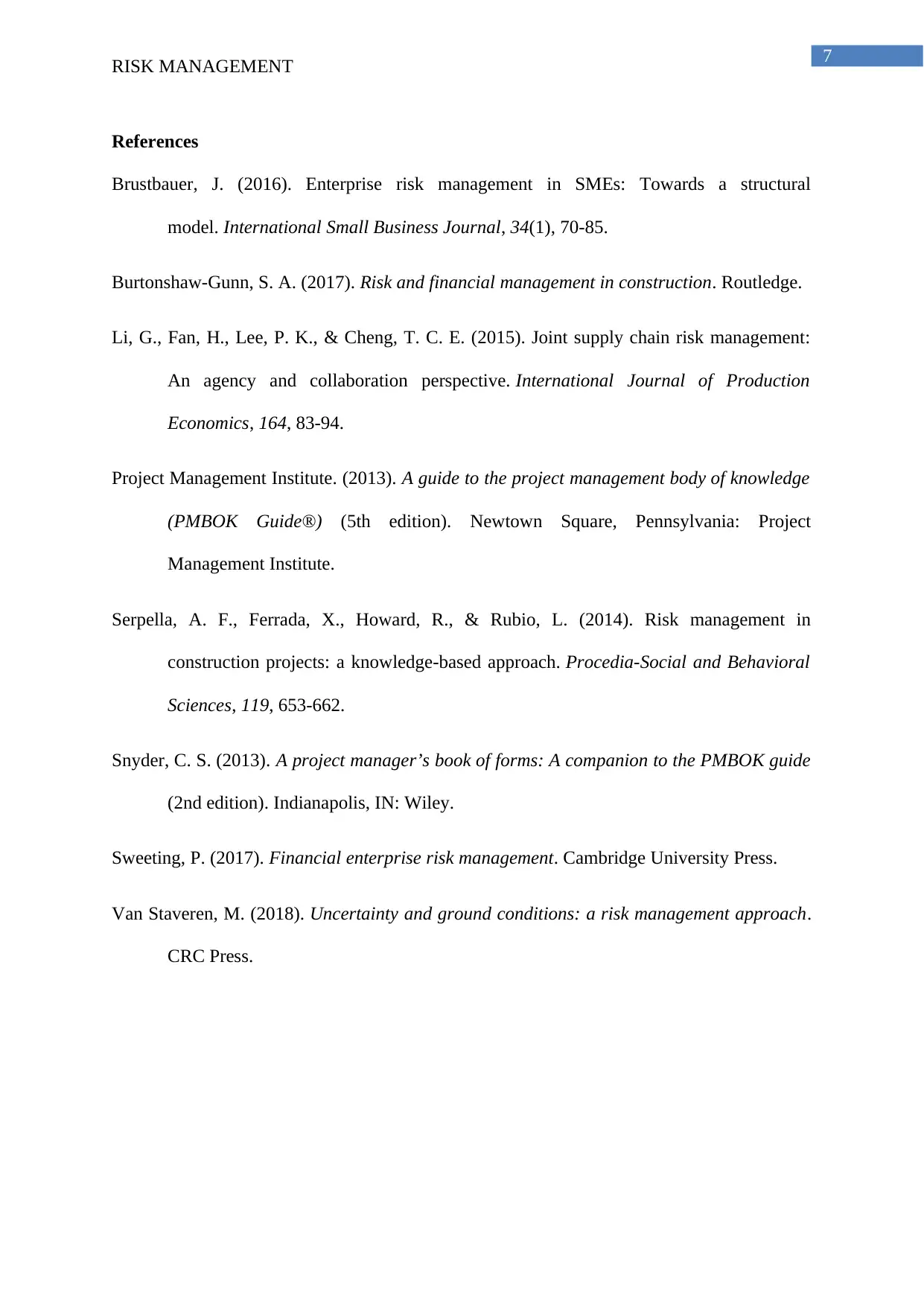
7
RISK MANAGEMENT
References
Brustbauer, J. (2016). Enterprise risk management in SMEs: Towards a structural
model. International Small Business Journal, 34(1), 70-85.
Burtonshaw-Gunn, S. A. (2017). Risk and financial management in construction. Routledge.
Li, G., Fan, H., Lee, P. K., & Cheng, T. C. E. (2015). Joint supply chain risk management:
An agency and collaboration perspective. International Journal of Production
Economics, 164, 83-94.
Project Management Institute. (2013). A guide to the project management body of knowledge
(PMBOK Guide®) (5th edition). Newtown Square, Pennsylvania: Project
Management Institute.
Serpella, A. F., Ferrada, X., Howard, R., & Rubio, L. (2014). Risk management in
construction projects: a knowledge-based approach. Procedia-Social and Behavioral
Sciences, 119, 653-662.
Snyder, C. S. (2013). A project manager’s book of forms: A companion to the PMBOK guide
(2nd edition). Indianapolis, IN: Wiley.
Sweeting, P. (2017). Financial enterprise risk management. Cambridge University Press.
Van Staveren, M. (2018). Uncertainty and ground conditions: a risk management approach.
CRC Press.
RISK MANAGEMENT
References
Brustbauer, J. (2016). Enterprise risk management in SMEs: Towards a structural
model. International Small Business Journal, 34(1), 70-85.
Burtonshaw-Gunn, S. A. (2017). Risk and financial management in construction. Routledge.
Li, G., Fan, H., Lee, P. K., & Cheng, T. C. E. (2015). Joint supply chain risk management:
An agency and collaboration perspective. International Journal of Production
Economics, 164, 83-94.
Project Management Institute. (2013). A guide to the project management body of knowledge
(PMBOK Guide®) (5th edition). Newtown Square, Pennsylvania: Project
Management Institute.
Serpella, A. F., Ferrada, X., Howard, R., & Rubio, L. (2014). Risk management in
construction projects: a knowledge-based approach. Procedia-Social and Behavioral
Sciences, 119, 653-662.
Snyder, C. S. (2013). A project manager’s book of forms: A companion to the PMBOK guide
(2nd edition). Indianapolis, IN: Wiley.
Sweeting, P. (2017). Financial enterprise risk management. Cambridge University Press.
Van Staveren, M. (2018). Uncertainty and ground conditions: a risk management approach.
CRC Press.
1 out of 8
Related Documents
Your All-in-One AI-Powered Toolkit for Academic Success.
+13062052269
info@desklib.com
Available 24*7 on WhatsApp / Email
![[object Object]](/_next/static/media/star-bottom.7253800d.svg)
Unlock your academic potential
Copyright © 2020–2025 A2Z Services. All Rights Reserved. Developed and managed by ZUCOL.




